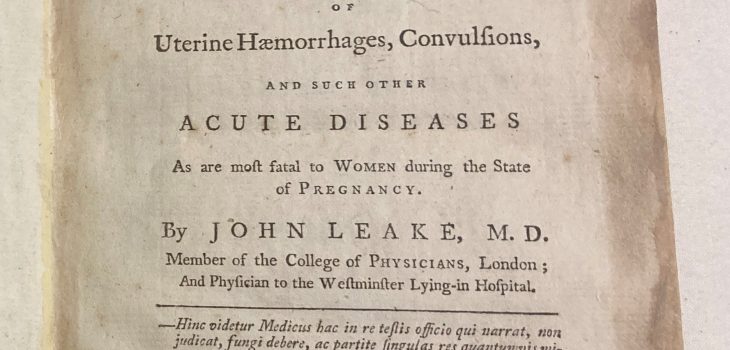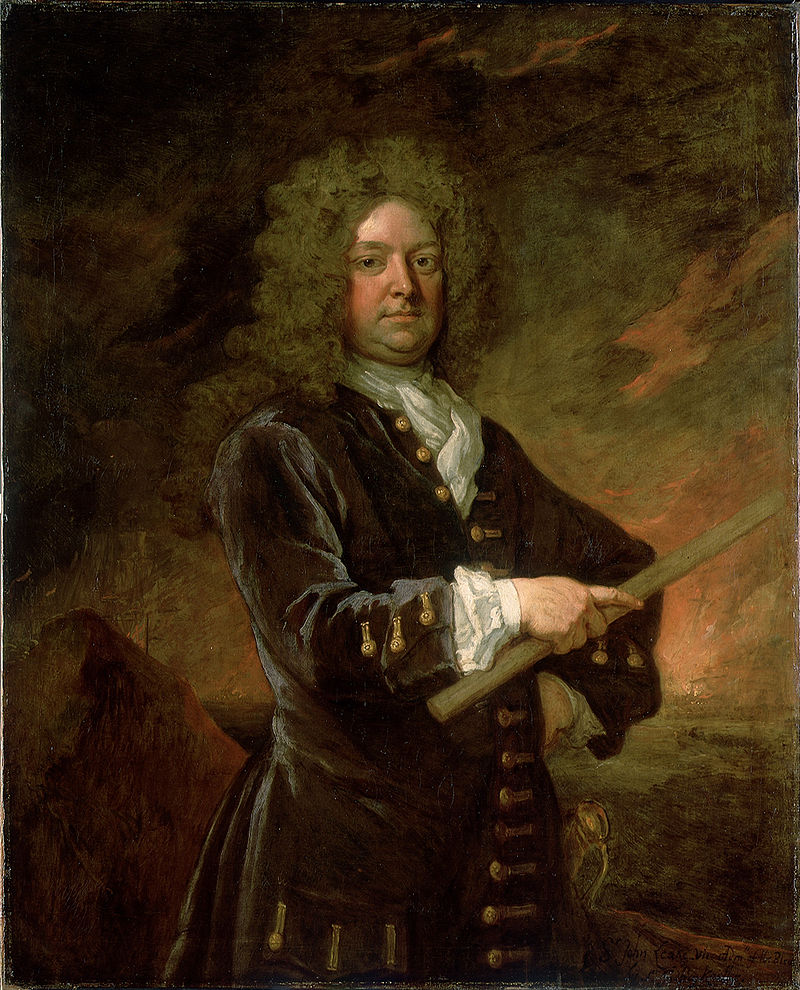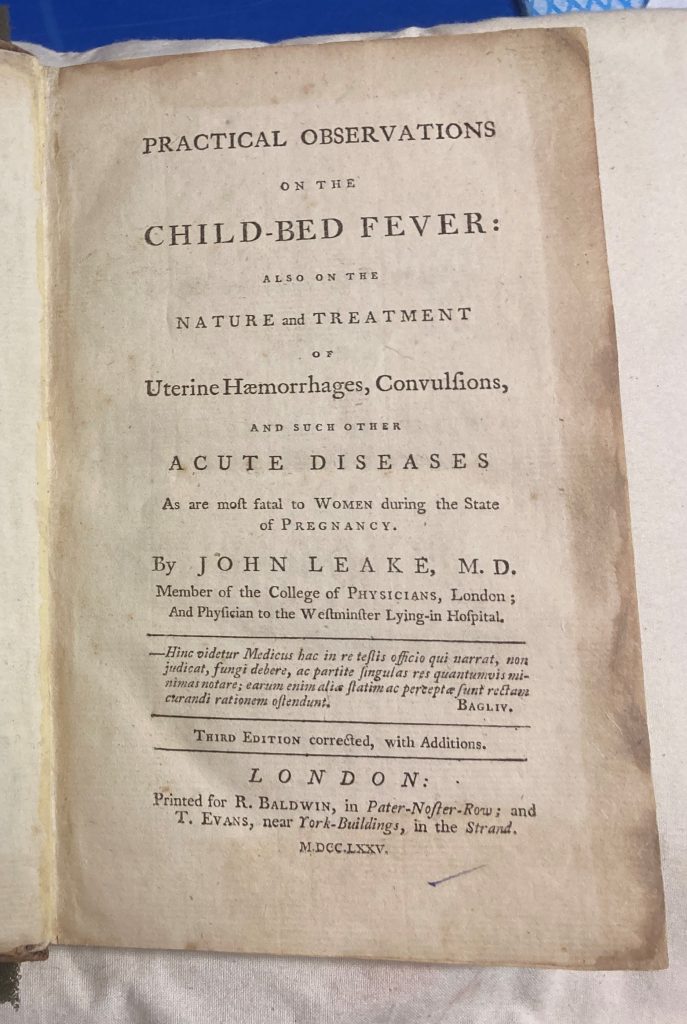In the 18th and 19th centuries and until the 20th Century the death of women in childbirth or shortly afterwards was a common occurrence. One early treatise on puerperal fever was written by John Leake, a physician and male midwife: Practical observations on the child-bed fever, first published in 1772.
Leake was born at Ainstable in Cumberland the son of a curate. His medical education included an apprenticeship with a London surgeon followed by training on the continent and the award of an MD at Rheims in 1763. In 1766 he was qualified to practice in London after obtaining a licentiate of the Royal College of Physicians of London. From the start of his career Leake specialized in midwifery. He obtained the support of wealthy benefactors to purchase land and build the New Westminster Lying-in Hospital south of Westminster Bridge (in an area that is now Waterloo) for pregnant women of poor families. Leake was put in charge of the hospital when it opened in 1767 : it was exceptional for the time in admitting single women but for one time only. Leake taught midwifery at his home and at the hospital and trained hundreds of students. He wrote Practical observations on the childbed fever, first published in 1772, and a major work on pregnancy and childbirth, Introduction to the theory and practice of midwifery, published in 1777. Leake died in London on 8 August 1792 aged 63.
Title page of Leake’s book Practical observations on the child-bed fever,1775
At a time when the cause of childbed fever was not known, different theories circulated as to its cause. Leake could not discover the cause but, correctly, he ‘insisted on the contagious nature of puerperal fever’ (Garrison-Morton) and he demanded that in his hospital clean bed linen and disinfectants were to be used to prevent the transmission of infection between patients. In 1847 the Hungarian-Austrian doctor Ignaz Semmelweis (1818-1865) observed the contagious nature of puerperal fever in his hospital. He proved the importance of hand-washing by medical staff by recording a reduction in fatalities in patients under his care. Unfortunately, Semmelweis could not prove the cause of puerperal fever either. Many doctors disagreed with his hypothesis and refused to adopt his recommendations for improved hygiene. The causative agent of puerperal fever, the bacterium Streptococcus pyogenes, was discovered in 1879 by Louis Pasteur (1822-1895) but it was not until 1935 that sulphonamides were found to be an effective antibacterial treatment (McGill University).
Cyril Barnard, the School’s first Librarian, bought books such as that by Leake to build a history of medicine collection. The LSHTM copy of Leake has no annotations or other marks of its earlier provenance, unlike many other books in the historical collection, before acquisition by Barnard, so we do not have any knowledge of its previous owners. It is bound in a plain brown full-leather binding and was recently conserved.
References
GARRISON-MORTON. An interactive annotated world bibliography of printed and digital works in the history of medicine and the life sciences from circa 2000 BCE to 2022 by F.H. Garrison, L.T. Morton and J.M. Norman. https://www.historyofmedicine.com/author/all/L/#john-leake (viewed 9 November 2023)
LEAKE, J., 1772. Practical observations on the childbed fever. London : J. Walker; 1775
Practical observations on the child-bed fever : also on the nature and treatment of uterine hæmorrhages, convulsions, and such other acute diseases as are most fatal to women during the state of pregnancy. Third edition, corrected, with additions. 393, [20] pages (LSHTM Library *JGR 1775)
McGILL UNIVERSITY. For an excellent history of puerperal fever see https://www.medicine.mcgill.ca/epidemiology/hanley/minimed/DiseaseMaryDobsonPuerperalFever.pdf (viewed 9 November 2023)
RHODES, P., 2004. Leake, John. Oxford Dictionary of National Biography 32 : 978-979.
LSHTM Library Rare Books Collection Blogs is an occasional posting highlighting books that are landmarks in the understanding of tropical medicine and public health. The Rare Books Collection was initiated by Cyril Cuthbert Barnard (1894-1959), the first LSHTM Librarian, from donations and purchases, assisted with grants from the Carnegie United Kingdom Trust. There are approximately 1600 historically important rare and antiquarian books in the Rare Books Collection.
Many of the LSHTM Library’s rare books were digitised as part of the UK Medical Heritage Library. This provides high-quality copyright-free downloads of over 200,000 books and pamphlets for the 19th and early 20th century. To help preserve the rare books, please consult the digital copy in the first instance.
If the book has not been digitised or if you need to consult the physical object, please request access on the Library’s Discover search service. Use the search function to find the book you would like to view. Click the title to view more information and then click ‘Request’. You can also email library@lshtm.ac.uk with details of the item you wish to view. A librarian will get in touch to arrange a time for you to view the item.
Researchers wishing to view the physical rare books must abide by the Guidelines for using the archives and complete and sign a registration form which signifies their agreement to abide by the archive rules. More information is available on the Visiting Archives webpage.






